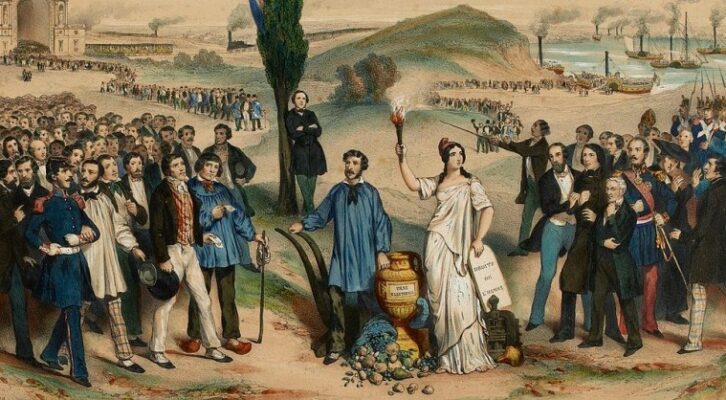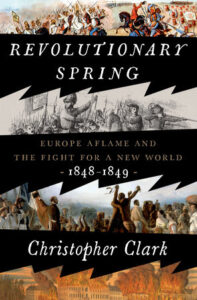
1848: Europe's Year of Revolt and Revolution
From Christopher Clark's Baillie Gifford Prize Shortlisted Revolutionary Spring
In their combination of intensity and geographical extent, the 1848 revolutions were unique—at least in European history. Neither the great French Revolution of 1789, nor the July Revolution of 1830, nor the Paris Commune of 1870, nor the Russian revolutions of 1905 and 1917 sparked a comparable transcontinental cascade. 1989 looks like a better comparator, but there is still controversy as to whether these uprisings can be characterized as “revolutions.” In 1848, by contrast, parallel political tumults broke out across the entire continent, from Switzerland and Portugal to Wallachia and Moldavia, from Norway, Denmark and Sweden to Palermo and the Ionian Islands. This was the only truly European revolution that there has ever been.
But it was also in some respects a global upheaval, or at least a European upheaval with a global dimension. The news of revolution in Paris had a profound impact on the French Caribbean, and the measures adopted by London to avoid revolution on the British mainland triggered protests and uprisings across the British imperial periphery. In the young nations of Latin America, too, the European revolutions galvanized liberal and radical political elites. Even in far-off Australia, the February Revolution created political waves—though it was not until June 19, 1848 that the news of the February events reached Sydney in the Colony of New South Wales—a reminder of what the Australian historian Geoffrey Blainey once mournfully described as “the tyranny of distance.”
For politically sentient Europeans, 1848 was an all-encompassing moment of shared experience.
The revolutions involved a vast panorama of charismatic and gifted actors, from Giuseppe Garibaldi to Marie d’Agoult, author (under a male pseudonym) of the best contemporary history of the revolutions in France, from the French socialist Louis Blanc to the leader of the Hungarian national movement, Lajos Kossuth; from the brilliant conservative liberal social theorist, historian and politician Alexis-Charles-Henri Clérel de Tocqueville to the Wallachian soldier, journalist and agrarian radical Nicolae Bălcescu. From the young patriot poet Sándor Petőfi, whose recitation of a new national song for the Hungarians electrified the revolutionary crowds in Budapest, to the troubled priest Félicité de Lamennais, whose ultimately unsuccessful struggle to reconcile his faith with his politics made him one of the most famous thinkers in the pre-1848 world; from the writer George Sand, who composed “revolutionary bulletins” for the Provisional Government in Paris, to the Roman popular tribune Angelo Brunetti, known affectionately as Ciceruacchio, or “Chubby,” a true man of the people, who did much to shape the unfolding of the Roman revolution of 1848–9. Not to mention the countless women who sold broadsheets and newspapers in the streets of the European cities or fought at the barricades (they are very prominent in the visual depiction of these revolutions). For politically sentient Europeans, 1848 was an all-encompassing moment of shared experience. It turned everyone into contemporaries, branding them with memories that would last as long as life itself.
These revolutions were experienced as European upheavals—the evidence for this is superabundant; but they were nationalized in retrospect. The historians and memory managers of the European nations absorbed them into specific national stories. The supposed failure of the German revolutions was sucked into the national narrative known as the Sonderweg, or “special path,” where it helped to power a thesis about Germany’s aberrant road into modernity, a road that culminated in the disaster of the Hitler dictatorship. Something similar happened in Italy, where the failure of revolution in 1848 was seen as pre-programming an authoritarian drift into the new Italian kingdom and thereby paving the road to the March on Rome in 1922 and the fascist seizure of power that followed. In France, the failure of 1848 was seen as ushering in the Bonapartist interlude of the Second Empire, which in turn anticipated the future triumph of Gaullism. In other words, focusing on the supposed failure of 1848 also had the consequence of allowing these stories to be channelled into a plurality of parallel, nation-state-focused narratives. Nothing demonstrates better than these connected upheavals and their fragmentation in modern memory the immense power of the nation-state as a way of framing the historical record—we are still feeling that power today.
____________________________________
Revolutionary Spring: Europe Aflame and the Fight for a New World, 1848-1849 by Christopher Clark has been shortlisted for the 2023 Baillie Gifford Prize for Non-Fiction.
____________________________________
There were three phases to the events of 1848. In February and March, upheaval spread like a brush fire across the continent, leaping from city to city and starting numerous spot-fires in towns and villages in-between. The Austrian Chancellor, Metternich, fled from Vienna, the Prussian army was withdrawn from Berlin, the kings of Piedmont–Sardinia, Denmark and Naples issued constitutions—it all seemed so easy. This was the Tahrir Square moment: one could be forgiven for thinking that the movement encompassed the entirety of society; the euphoria of unanimity was intoxicating; “I had to go out into the winter cold and walk and walk until I had worn myself out,” one German radical wrote, “just to calm my blood and slow down the beating of my heart, which was in a state of unprecedented and baffled agitation and felt as if it were about to blow a hole in my chest.” In Milan, complete strangers embraced each other in the streets. These were the spring days of 1848.
Yet the divisions within the upheaval (already latent in the first hours of conflict) soon became glaringly apparent: by May, radical demonstrators were attempting to storm and overthrow the National Assembly created by the February Revolution in Paris, while, in Vienna, Austrian democrats protested at the slowness of liberal reforms and established a Committee of Public Safety. In June, there were violent clashes between the liberal (or in France republican) leaderships and radical crowds on the streets of the larger cities. In Paris, this culminated in the brutality and bloodshed of the “June Days,” which killed at least 3,000 insurgents. This was the long hot summer of 1848, gleefully diagnosed by Marx as the moment at which the revolution lost its innocence and the sweet (but deceptive) unanimity of spring made way for the bitter struggle between classes.
__________________________________

Excerpted from Revolutionary Spring: Europe Aflame and the Fight for a New World, 1848-1849 by Christopher Clark. Copyright © 2023. Available from Crown, an imprint of Crown Publishing Group, a division of Penguin Random House, LLC.
Christopher Clark
Christopher Clark is a professor of modern European history and a fellow of St. Catharine’s College at the University of Cambridge. He is the author of The Sleepwalkers, Time and Power, Iron Kingdom, and other books.



















